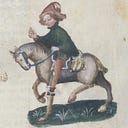Member-only story
‘There the Cords of Life Broke’: Attitudes Towards Death, Dying, and the Deceased in Early Modern England
Death is the inevitable end of life. Indeed, our conception of ‘life’ is dependent on our notion of death. This fact has remained unchanged for the entirety of human existence and has been understood by humans for as long as they’ve existed. However, the immutable nature of death does not mean that attitudes towards it have not changed. On the contrary, the evolution of culture, religion, and technology have greatly altered our understanding and perception of death.
In this article, I intend to look back at what we know of attitudes towards death in early modern England through depictions of it in popular culture. Death cannot be eluded and the concept of inevitability was a well-known and prominent aspect to this discussion in early modern England. In Act 1, Scene 2 of William Shakespeare’s Hamlet, Gertrude tells Hamlet ‘Thou know’st ’tis common; all that lives must die.’ It is this truism, which both makes death something greatly feared yet illogical to fear. An aspect of death’s universality is that it cares not for rank, wealth, or class. This was a popular theme as well in early modern England. Thomas Hill’s famous 17th-century ballad ‘The Doleful Dance and Sad Song of Death’ describes death as ‘a dance that every one must do’ including ‘the beggar and the King…
